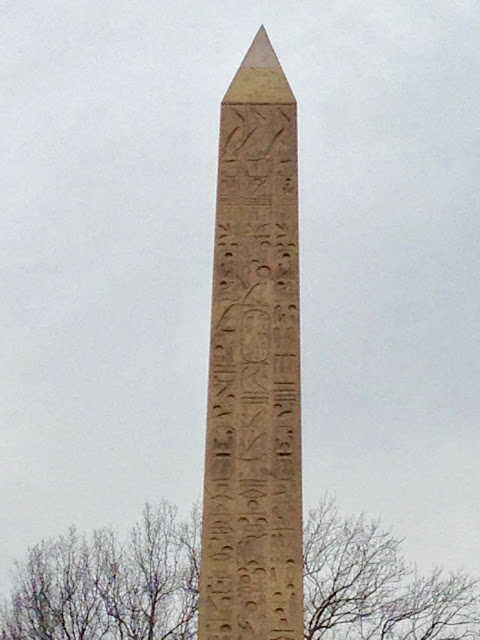When I visited on a recent afternoon there was one other person checking it out, who left soon and gave me the place to myself.
Contrast that with the ancient Egyptian room in the Met that is great to visit and explore but certainly will have crowds joining you. It's a shame that the obelisk is just feet away from the museum and yet practically forgotten, especially considering that it is the oldest public monument in the city.
It is also just steps away from the Great Lawn on its other side, which possibly gives it some more foot traffic during the warmer months.
Shortly after I arrived and started taking photos and reading the plaques, small numbers of tourists started to show up, never exceeding four or five overall but still suddenly seeming like a lot.
Just at the top of the steps leading to the obelisk is a plaque full of interesting information, including history and dimensions and recent conservation efforts to revitalize the structure.
This obelisk is one of two that was built in Heliopolis at the Temple of the Sun (the other one is now in London). Pharaoh Thutmose III had it built, and the hieroglyphs on its four sides praise him and later rulers as well.
There is a plaque at the base of each side that translates what is written. Here is a brief sample of one plaque:
The Horus, Strong-
Bull-Son-of-Ra,
the King of Upper and
Lower Egypt,
User-maat-ra, Chosen-
of-Ra, he of the Two
Goddesses,
Protector-of-Egypt-and-
curber-of-foreign-lands,
the Son of Ra,
Ramesses Beloved-of-
Amun, a king excellent
like Ra,
...
That's the basic feel of all the translations. Thanks to restoration efforts by the Central Park Conservancy in 2011, a lot more of the hieroglyphs can now be seen. The process included use of lasers that removed dirt without touching the actual object. Experts say that the eroded parts of the hieroglyphs were not affected by recent wear and tear, but rather by moisture that it was exposed to for hundreds of years when it had fallen over and was semi-buried in Egypt.
The recent restoration effort occurred shortly after a warning from Egypt that it would take back the obelisk if it were not taken better care of. This detail is not included on the plaque at the site.
A true obelisk, such as this one, is carved from one stone. Most modern obelisks, for example the Washington Monument, are made from numerous stones put together. Carving it from one stone seems like more of an accomplishment, especially considering that this granite obelisk weighs 220 tons.
Upon close inspection of the obelisk, the first feature that jumped out was naturally the hieroglyphs, but soon after I noticed lobster claws sticking out from the base.
This was confusing and amusing, as Walt Frazier might say. I soon learned that they are actually crabs and were added by the Romans because of damaged corners, along with the limestone steps at the bottom, when they discovered the fallen obelisks around 12 B.C.E. and transported them to a temple honoring Julius Caesar in Alexandria, Egypt.
The original bronze crabs from the Romans are now in the Met and replicas are on the obelisk, which explains why I thought they looked surprisingly good for being thousands of years old.
In the 19th century, Egypt was gifting artifacts to European countries to help diplomatic relationships. The Khedive of Egypt offered this obelisk to America in 1869 for the same reason, and its transport took so much planning and effort that it didn't arrive in its current spot in Central Park until 1881.
And here it stands, waiting for just a visitor or two. It doesn't ask for much.











No comments:
Post a Comment